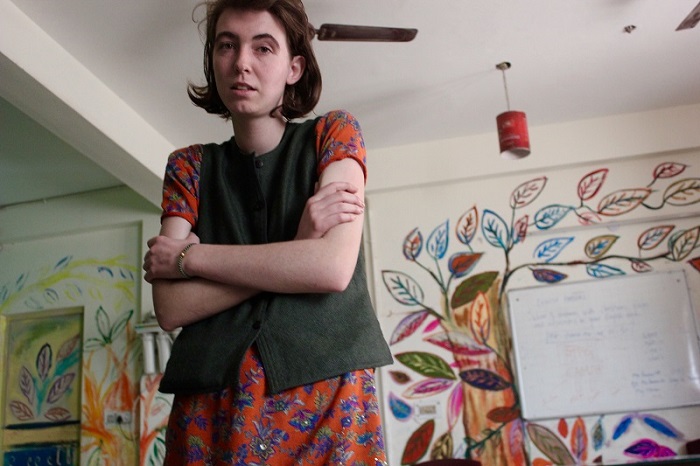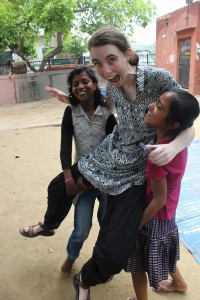
Surprisingly, wearing kurtis (long tops worn in South Asia) for a year did not induce the kind of trepidation I feel when confronted with the normatively female clothes that hang in my wardrobe for occasions (usually involving my mother) on which I have to wear them. In all other circumstances I prefer to dress in clothes typically associated with masculinity. In India, rather than my home country Australia, some of the anxiety about wearing ‘girls’ clothes’ was displaced by a sense that no matter how hard I tried, I wasn’t going to fit in anyway. In India, my gender and sexuality seemed largely secondary to my out-of-placeness as a foreigner, which was both incredibly liberating and deeply uneasy.
In India I enjoyed some freedom from what I have come to consider a life-long companion, an anxious bundle of feelings structured around the idea of being a ‘real girl’: where not feeling like a ‘real girl’ is often indistinguishable from being made to feel like a failed girl. I consider this feeling life-long because of my unwillingness to trade it for a label like trans, a label I fear will sit just as uneasily.
In Delhi, however, for the first time in my life, my gender became secondary to my race, and I experienced what I could not in my home country where the privileged position of whiteness (built on the back of black deaths and genocide) meant my race was invisible. With my skin itself (and not what I covered it with) seemingly having the most significance, I presumed, at least initially, that my sexual orientation as a lesbian, if at all noticeable, would simply blur into the general strangeness of my foreignness.
And foreigners were meant to be strange, right? Here, far from home, I was meant to feel and look strange in my own skin. And I did, but with none of the self-consciousness I felt in Australia, where a part of me always insisted that I was somehow meant to fit in. Yet, despite the intervention of many well-meaning aunties and friends over cups of chai, I don’t think I was aware of how truly strange, let’s even say ridiculous, I looked at the time. Because although I was wearing kurtis nearly every day, I didn’t really understand the ‘rules’ of wearing kurtis. I would always leave my dupatta (a long scarf) at home, I would wear my salwars and churidars (kinds of pants) so low on my hips that aunties would continually be tugging up my pants. My hairy arms and legs were stroked and continually remarked upon by strangers. But just like at home where I had never ‘got it’, I never got it in India either.
Sometimes when I caught myself in the mirror, with longish hair (which I cut after six months of growing it in a moment of anguish when my partner at the time told me she was going back to Australia), bright, colourful clothes and unfamiliar shoes, I often did not see ‘myself’. But this didn’t always bother me; I was, after all, in Delhi to conduct my doctoral research as an anthropologist. I wanted to listen and learn, and I wanted to present myself in ways that encouraged that. I kept telling myself, “This is not about me.” I was both wrong and right.
It bothered me most when I would spend time in queer spaces, where despite my strangeness and my inability to express externally any meaningful gender/sexual identity, I was welcomed warmly. I did buy some shirts and pants to wear, but my hair was always too long, too girly, the weather so much warmer than home, the ‘rules’ so elusive, I never got it right. Or because maybe no one else noticed, it is more accurate to say I never felt right.
Even now I have a drawer at home, in Australia, that I never open (because it’s “cultural appropriation” if you do it in your own country and “trying to fit in” when you do it in theirs, right? I just don’t know anymore), where I keep my ‘India clothes’ in the same way as I used to keep my school uniform as a child.
In a parting conversation with a group of girls I worked with, (my research explored the way slum children challenge the terms upon which they are ‘developed’ by local NGOs) several girls asked me to ‘pucca promise’ (make a ‘sure’ promise) that I would grow my hair, get married and be beautiful. Knowing full-well the impossibility of this, but also realising how even at home I could not explain ‘why’ this would not be possible to some of my family, I quickly agreed. “Pucca,” I said, nodding my head slightly in the way I had learned. A week later, back in Australia, I cut my hair. It has stayed short since then, apart from a brief period when I let it grow from ‘early Beatles’ all the way to ‘Jim Morrison from The Doors’.
I haven’t been back to India. If you asked me what was stopping me, I wouldn’t be entirely lying if I said, “My hair.”
While my hair will grow again if I let it, the discomfort I feel at lying to the children who I invited to confide in me and whose stories and lives I am building (maybe) my academic career upon, leaves me with a crippling feeling of unease.
Sometimes when I am trying to make myself feel better for lying, I tell myself the stories of those who saw through my lies. Stories of the woman from the small village of outside Uttarkashi who, when I said I did not like men – my typical response to questions about why I was not married – asked me the question that no one else had, “Do you like women?” “Yes,” I eagerly said. “Me too,” she said as she began to tell me a story, long and painful.
Stories of my favourite boy (though we anthropologists are not meant to have favourites) who, though sixteen, skipped lightly across the room and shared with me his drawings, and allowed me to see how the other boys hurt him with their merciless teasing.
The story of the rickshaw driver who caught me checking out a beautiful woman and who, either sensing the shared moment, or out of fear that I had caught him, fixed my eyes in the rear-view mirror and said with a shake of his head, “Bahut achchi ladki hai na?” (“She’s a very attractive girl, isn’t she?”)
And the story of the person I never spoke to, whose gender and sexual identity I never knew, but with whom I shared a moment of intense recognition. Walking in the subway near my house one day, I passed a person, someone it seemed to me at the time to be like me, not how I looked but how I felt. As we walked past each other, we looked intensely at each other; after our shoulders had passed one another nearly touching in the crowd, we both took exactly three steps before turning around and again meeting each other’s gaze. We held it for a second before again walking on in opposite directions. There were no words, there seemed to be no need for words.
Images courtesy the author.
